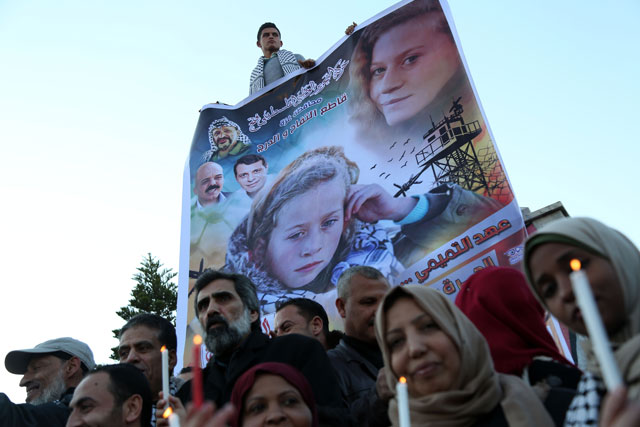
Last month, a video went viral of a young Palestinian woman, 16-year-old Ahed al-Tamimi (now 17) in an altercation with two Israeli soldiers. Tensions escalated, as the soldiers appeared to laugh at and taunt her until she repeatedly pushed and kicked them. Subsequently, the Israeli state arrested and charged Tamimi with 12 counts of assault, incitement and throwing stones, and today she remains in jail awaiting trial.
Documenting scenes of the dispossessed confronting state power has escalated with the increased accessibility of smartphones. Both recording and circulating videos through social media has become a strategic tool in efforts to publicize state violence. Like resistance efforts elsewhere, pro-Palestinian activists have increasingly relied on this technology to counter Israeli state’s efforts to silence opposition through media censorship and the military courts.
Without taking anything away from the ability of videos to show the horrific impacts of state violence, it is worth pausing to consider why this particular video went viral. To many, the video powerfully conveys the anger, frustration and courage of a young woman being mocked by male soldiers whose power leaches through the weapons they hold. Far from being interpreted from a singular position, however, Tamimi has become a symbol mobilized as much by pro-Israeli commentators as by those who support the Palestinian resistance movement. Opposing headlines claiming her to be a child victim, a heroine or a fraud too often preface commentaries that ignore her voice, and thus fail to convey Tamimi and her family’s lived experiences. Recognition of the contributions and limitations of video documentation is, therefore, vital in order to render them politically viable in support of the Palestinian struggle.
Competing interpretations stem in large measure from the broader contexts through which people see the video. For instance, the ominous sensation that pervades the video intensifies if you are aware that Tamimi had just learned that an Israeli soldier had shot her cousin, 15-year-old Mohammed Fadl al-Tamimi, in the head with a rubber bullet. Likewise, for those viewing the video since Tamimi’s appearance in court in early January, the ensuing arrests, the years in prison she potentially faces and the fact that Israeli prosecutors have nearly a 100 percent success rate in such cases retrospectively heightens attention to the already palpable violence in the video. The deeper legacy of economic subjugation and the loss of village lands confiscated for Israeli settlements, to say nothing of multigenerational experiences of occupation, further contextualize the young woman’s actions. Unexceptional, some commentators observe, Tamimi exemplifies a generation of young Palestinians who routinely endure traumas such as deaths and injuries sustained by relatives and friends, nighttime arrests and the bulldozing of homes, to name but a few of the social, psychological and physical injuries they face daily.
Other contexts, however, make video technology not quite as reliable a truth-telling medium as we sometimes presume. Pro-Israeli commentators point to the decades-long political activism of Tamimi’s parents and other relatives. Rather than exemplify youthful resistance to the Occupation, these critics insist that the video reveals these Palestinians to be provocateurs who threaten Israeli security. Tamimi’s age, they argue, demonstrates the willingness of her activist parents to exploit her in support of their agendas.
Importantly, the mediated process of turning Tamimi into a contested symbol resides in how commentators react to her race, gender and age. Watching a young woman lash out at the soldiers can destabilize conventional assumptions about Palestinian women as deferential and subservient. Supporters note that she follows in the footsteps of a long and valued history of women’s activism in Palestine. In Israel, gender too has become a focal point of debates, as some commentators have mobilized nationalist anxieties in response to the emasculating implications of a 16-year-old girl shaming these soldiers. Likewise, critics often rely on simplistic racial assessments of Tamimi’s blond curly hair and blue eyes, most prominently those who charge that she and/or her parents have skillfully exploited her “Westernized” looks on social media.
What lessons one takes from the emergence of Tamimi as a symbol of Palestinian resistance are deeply entrenched in the cultural politics of perception. Individuals get elevated to symbolic status when others see them as exemplifying broader political forces. Even as we can recognize Tamimi as a representative figure, it is well worth remembering that at the heart of this vexed debate about social media and Palestinian resistance is a teenager whose daily experiences, as well as dreams and desires, are elided in our hurry to claim her as our symbol.
Angry, shocked, overwhelmed? Take action: Support independent media.
We’ve borne witness to a chaotic first few months in Trump’s presidency.
Over the last months, each executive order has delivered shock and bewilderment — a core part of a strategy to make the right-wing turn feel inevitable and overwhelming. But, as organizer Sandra Avalos implored us to remember in Truthout last November, “Together, we are more powerful than Trump.”
Indeed, the Trump administration is pushing through executive orders, but — as we’ve reported at Truthout — many are in legal limbo and face court challenges from unions and civil rights groups. Efforts to quash anti-racist teaching and DEI programs are stalled by education faculty, staff, and students refusing to comply. And communities across the country are coming together to raise the alarm on ICE raids, inform neighbors of their civil rights, and protect each other in moving shows of solidarity.
It will be a long fight ahead. And as nonprofit movement media, Truthout plans to be there documenting and uplifting resistance.
As we undertake this life-sustaining work, we appeal for your support. We have 9 days left in our fundraiser: Please, if you find value in what we do, join our community of sustainers by making a monthly or one-time gift.